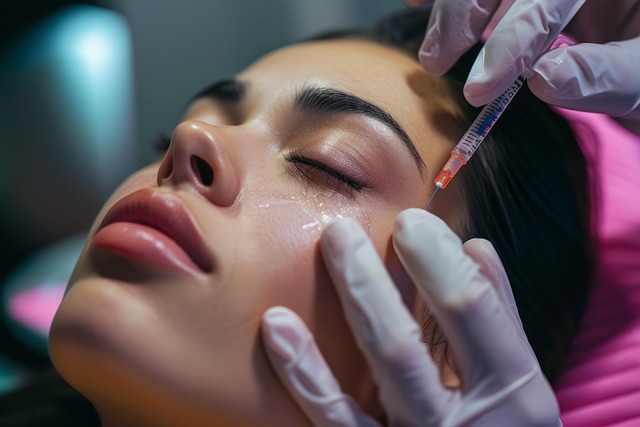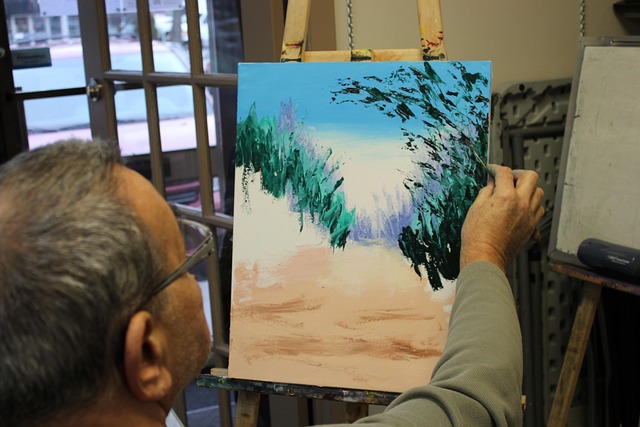Deep forehead wrinkles caused by aging can be effectively treated with Botox for Fine Lines and Wrinkles, a non-surgical procedure relaxing facial muscles to prevent wrinkle formation. With minor temporary side effects, Botox offers fast results (visible within 24-72 hours) lasting 3-6 months, providing a safer, quicker alternative to surgery with no recovery time. Combining Botox with holistic skincare practices can enhance its anti-aging benefits for a more youthful complexion. Choosing qualified professionals using FDA-approved products is crucial for optimal and safe results in reducing fine lines and wrinkles.
“Uncover the secret to a smoother forehead with Botox, a game-changer in non-surgical wrinkle treatments. Deep forehead wrinkles, often a sign of aging or expression lines, can be effectively managed with this popular solution. This comprehensive guide delves into the science behind Botox, its mechanisms in reducing forehead lines, and its safety profile. From understanding the causes to navigating potential side effects, we explore everything you need to know about Botox for fine lines and wrinkles. Embrace a youthful glow and discover how this treatment can transform your facial aesthetics.”
Understanding Deep Forehead Wrinkles: Causes and Impact

Deep forehead wrinkles, often referred to as frown lines or glabelar lines, are a common concern for many individuals. These wrinkles can be a result of various factors, including age, facial expressions, and genetics. As we age, our skin’s elasticity decreases, causing these deep folds to form, especially in areas of high muscle activity like the forehead.
The impact of deep forehead wrinkles goes beyond aesthetics. Beyond causing concern about appearance, they can also affect one’s self-confidence and overall mood. Botox for fine lines and wrinkles has emerged as a popular solution. By injecting botulinum toxin into specific muscles, Botox can temporarily relax them, preventing the contraction that leads to wrinkle formation. This non-surgical procedure offers a safe and effective way to reduce the depth and visibility of deep forehead wrinkles.
Botox: A Non-Surgical Wrinkle Treatment

Botox is a popular, non-surgical treatment option for those seeking to reduce the appearance of fine lines and wrinkles, particularly in delicate areas like the forehead. It works by injecting a small amount of botulinum toxin into specific muscle groups, temporarily paralyzing them and preventing the contractions that contribute to wrinkle formation. This simple procedure offers a significant advantage over surgical options as it provides a quick, effective solution without the need for recovery time.
The beauty of Botox lies in its ability to smooth out deep wrinkles, giving the skin a more youthful appearance. For individuals with prominent forehead lines or frown lines between the eyebrows, Botox can be highly effective in minimizing their depth and visibility. This treatment is especially appealing as it offers a long-lasting result, often lasting 3-6 months, depending on individual metabolism and lifestyle factors.
How Botox Works to Reduce Forehead Lines

Botox, a protein derived from bacteria, has become a popular non-surgical treatment for deep forehead wrinkles and fine lines. Its mechanism of action involves blocking the release of a neurotransmitter called acetylcholine in the muscles responsible for facial expressions. This disrupts muscle contraction, preventing the formation of dynamic wrinkles, especially those caused by frowning or squinting. Over time, as treatments are repeated, Botox can also weaken dynamic muscles, reducing static wrinkles that persist even when muscles are at rest. By targeting these specific muscle groups, Botox offers a safe and effective way to minimize the appearance of deep forehead lines, providing a smoother, more youthful complexion.
The Safety Profile of Botox for Facial Wrinkles

Botox is a popular and safe option for treating deep forehead wrinkles, also known as glabellar lines. Numerous clinical studies have evaluated its efficacy and safety profile for facial wrinkle reduction. These studies consistently show that Botox injections are generally well-tolerated by most patients. Common side effects include temporary redness, swelling, or mild discomfort at the injection site. In rare cases, patients may experience more severe reactions, such as bruising or headaches, but these typically resolve within a few days.
The safety of Botox for fine lines and wrinkles is further supported by its regulatory approval from health authorities worldwide. These approvals are based on rigorous testing and clinical trials, ensuring that the benefits outweigh any potential risks. As with any medical procedure, it’s crucial to consult a qualified healthcare provider who can assess your specific needs and ensure the treatment is suitable for you.
What to Expect During a Botox Procedure

During a Botox procedure for deep forehead wrinkles, a healthcare professional will begin by cleaning your skin and applying a topical anesthetic to minimize any discomfort. The injection process itself is relatively quick, typically taking around 15-30 minutes. A small needle is used to inject Botox into specific muscles in the forehead, carefully targeting the areas of deep wrinkles or frown lines. The injections are usually well-tolerated, and many patients report only minor temporary redness or swelling at the injection sites.
After the procedure, you may experience a slight tingling or numbness that should subside within a few hours. It’s important to follow your doctor’s aftercare instructions, which may include avoiding strenuous activities for a short period and protecting your skin from direct sunlight. The results of Botox for fine lines and wrinkles typically start to become visible within 24-72 hours, with the full effect achieved around 1-2 weeks post-treatment.
Potential Side Effects and Management

Botox for fine lines and wrinkles has proven effective in treating deep forehead wrinkles, but like any medical procedure, it carries potential side effects. Common temporary issues include mild bruising, swelling, or headaches at the injection site. These usually subside within a few days. In rare cases, patients may experience more severe reactions, such as difficulty swallowing or speaking, which require immediate medical attention. To manage these risks, it’s crucial to choose an experienced and board-certified provider who uses sterile techniques and follows safe injection practices.
To minimize side effects, patients should discuss their medical history and any medications they’re taking with their doctor before the procedure. Post-treatment care includes resting, avoiding strenuous activities, and applying a cold compress to reduce swelling. Following these guidelines can help ensure a smoother recovery and enhance the overall effectiveness of Botox for fine lines and wrinkles.
Results and Duration of Botox Treatments

Botox treatments for deep forehead wrinkles offer a significant improvement in the appearance of fine lines and wrinkles, providing a smoother, more youthful complexion. This non-surgical procedure works by relaxing the muscles responsible for causing dynamic wrinkle formation. The results are typically visible within 2-4 days after treatment, with optimal effects achieved within about 7-10 days. The duration of the effects can vary depending on individual factors such as age, skin type, and lifestyle. On average, Botox treatments last between 3 to 6 months, after which top-up sessions may be recommended to maintain the desired results.
The longevity of Botox for fine lines and wrinkles makes it a popular choice for those seeking effective yet temporary solutions. It allows individuals to achieve a more relaxed and youthful appearance without the need for extensive surgery or long recovery periods. This versatility has contributed to its growing popularity as a cosmetic treatment, offering patients a way to combat age-related changes in a minimally invasive manner.
Combining Botox with Other Anti-Aging Strategies

Many individuals seeking Botox for deep forehead wrinkles also integrate other anti-aging strategies into their routines. This comprehensive approach to skincare is key in achieving and maintaining youthful-looking skin. By combining Botox, a powerful tool for smoothing fine lines and wrinkles, with topical creams, healthy diet, and regular exercise, you can enhance the overall effectiveness of your anti-aging regimen. Topical retinoids, for instance, can stimulate collagen production while protecting against sun damage—a common contributor to premature aging.
Additionally, staying hydrated and maintaining a balanced diet rich in antioxidants supports skin health from within. Regular physical activity improves blood circulation, delivering essential nutrients to the skin while promoting a healthier, more radiant complexion. When paired with Botox treatments, these strategies can complement each other, providing multi-faceted benefits for a more substantial and lasting impact on reducing deep forehead wrinkles.
Finding Qualified Medical Professionals for Botox Administration

When considering Botox for deep forehead wrinkles, finding qualified medical professionals is paramount to achieving safe and effective results. It’s crucial to select practitioners with extensive experience in botulinum toxin injections, as this ensures a low risk of adverse reactions. Look for board-certified dermatologists or plastic surgeons who specialize in aesthetic treatments, as they have the expertise to identify and treat specific wrinkle concerns, including those deep set in the forehead.
Reputation is key; consult with friends, family, or read online reviews to gauge the skills and customer satisfaction of potential practitioners. Ensure the professional you choose follows proper safety protocols and uses pre-tested, FDA-approved Botox products for treating fine lines and wrinkles. A qualified medical expert will assess your unique situation, discuss expectations, and provide a tailored treatment plan, ensuring optimal outcomes for your specific needs.
